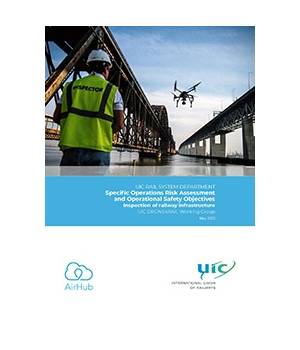
Specific Operations Risk Assessment and Operational Safety Objectives
Unmanned Aerial Vehicles (UAV) are a reality to extract meaningful insights to support maintenance processes. In the infrastructure sector it is becoming a powerful and safe tool to reduce cost and simplify maintenance operations. To ensure the long-term performance of infrastructure assets such as bridges, innovative methods are required to efficiently record the state of the structure and, on this basis, make safety statements and service life forecasts
Railway Infrastructure Managers from all over Europe have participated in the UIC-project “DRONE4RAIL - Harmonised methodology for drone / UAV use for bridge inspections” to research the use of drones for railway bridges inspections.
A SORA (Specific Operational Risk Assessment) is a European-wide procedure for risk analysis for the use of unmanned flight systems. SORA is used as a multi-stage process of risk assessment and is intended to improve safety for the use of drones.
The purpose of this work is to provide outputs of a SORA developed for the railway sector and evaluated by European Union Aviation Safety Agency (EASA). The ultimate objective is to support Infrastructure Managers on Inspection of Railway Infrastructure. The resulting Operational Safety objectives (OSO) are also shown, including guidelines on how to implement the requirements provided by the SORA.
The following criteria was considered to assess the risk of the drone flight: operation area, airspace, flight system, purpose of operation and knowledge of the controller. This SORA/OSO analysis was carried out for one of the bridges inspected during the Drone4Rail project: railway bridge over the River Waal, at Nijmegen, The Netherlands.
| Author | UIC |
| ISBN | 978-2-7461-3181-1 |
| Pages | 52 |
Fiche technique
- Langage
- Anglais
- Format
- Téléchargeable
- Edition
- Ed. no.1
- Date d'édition
- 01/05/2022
- Date de publication
- 10/05/2022
- Nombre de pages
- 52
- Thème
- Infrastructure Infrastructure Technology Technologie
- sku
- 5-22001E-PDF
- Reference
- 5-22001E
 Préférences sur les cookies
Préférences sur les cookies

